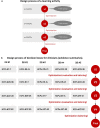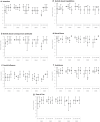User-centered and theory-based design of a professional training program on shared decision-making with older adults living with neurocognitive disorders: a mixed-methods study
- PMID: 33596874
- PMCID: PMC7888116
- DOI: 10.1186/s12911-021-01396-y
User-centered and theory-based design of a professional training program on shared decision-making with older adults living with neurocognitive disorders: a mixed-methods study
Abstract
Background: We know little about the best approaches to design training for healthcare professionals. We thus studied how user-centered and theory-based design contribute to the development of a distance learning program for professionals, to increase their shared decision-making (SDM) with older adults living with neurocognitive disorders and their caregivers.
Methods: In this mixed-methods study, healthcare professionals who worked in family medicine clinics and homecare services evaluated a training program in a user-centered approach with several iterative phases of quantitative and qualitative evaluation, each followed by modifications. The program comprised an e-learning activity and five evidence summaries. A subsample assessed the e-learning activity during semi-structured think-aloud sessions. A second subsample assessed the evidence summaries they received by email. All participants completed a theory-based questionnaire to assess their intention to adopt SDM. Descriptive statistical analyses and qualitative thematic analyses were integrated at each round to prioritize training improvements with regard to the determinants most likely to influence participants' intention.
Results: Of 106 participants, 98 completed their evaluations of either the e-learning activity or evidence summary (93%). The professions most represented were physicians (60%) and nurses (15%). Professionals valued the e-learning component to gain knowledge on the theory and practice of SDM, and the evidence summaries to apply the knowledge gained through the e-learning activity to diverse clinical contexts. The iterative design process allowed addressing most weaknesses reported. Participants' intentions to adopt SDM and to use the summaries were high at baseline and remained positive as the rounds progressed. Attitude and social influence significantly influenced participants' intention to use the evidence summaries (P < 0.0001). Despite strong intention and the tailoring of tools to users, certain factors external to the training program can still influence the effective use of these tools and the adoption of SDM in practice.
Conclusions: A theory-based and user-centered design approach for continuing professional development interventions on SDM with older adults living with neurocognitive disorders and their caregivers appeared useful to identify the most important determinants of learners' intentions to use SDM in their practice, and validate our initial interpretations of learners' assessments during the subsequent evaluation round.
Keywords: Aging; Behaviour change technique; Continuing professional development; Curricular development; Dementia; Implementation; Intervention design; User experience.
Conflict of interest statement
The authors declare that they have no competing interests.
Figures





Similar articles
-
Professional training on shared decision making with older adults living with neurocognitive disorders: a mixed-methods implementation study.BMC Med Inform Decis Mak. 2020 Aug 12;20(1):189. doi: 10.1186/s12911-020-01197-9. BMC Med Inform Decis Mak. 2020. PMID: 32787829 Free PMC article.
-
Effectiveness of interprofessional shared decision-making training: A mixed-method study.Patient Educ Couns. 2022 Nov;105(11):3287-3297. doi: 10.1016/j.pec.2022.07.010. Epub 2022 Jul 20. Patient Educ Couns. 2022. PMID: 35927112
-
Tailoring and evaluating an intervention to improve shared decision-making among seniors with dementia, their caregivers, and healthcare providers: study protocol for a randomized controlled trial.Trials. 2018 Jun 25;19(1):332. doi: 10.1186/s13063-018-2697-1. Trials. 2018. PMID: 29941020 Free PMC article.
-
Implementing shared decision making according to the choosing wisely programme: Perioperative medicine for older people undergoing surgery.J Eval Clin Pract. 2023 Aug;29(5):774-780. doi: 10.1111/jep.13827. Epub 2023 Apr 11. J Eval Clin Pract. 2023. PMID: 37042068 Review.
-
A scoping review of interventions to promote the adoption of shared decision-making (SDM) among health care professionals in clinical practice.Patient Educ Couns. 2019 Jun;102(6):1057-1066. doi: 10.1016/j.pec.2019.01.001. Epub 2019 Jan 3. Patient Educ Couns. 2019. PMID: 30642716
Cited by
-
Use of the CPD-REACTION Questionnaire to Evaluate Continuing Professional Development Activities for Health Professionals: Systematic Review.JMIR Med Educ. 2022 May 2;8(2):e36948. doi: 10.2196/36948. JMIR Med Educ. 2022. PMID: 35318188 Free PMC article. Review.
-
Exploring a career pathway for home support workers in Ireland: a systematic scoping review of the international evidence.Front Health Serv. 2024 Mar 13;4:1360920. doi: 10.3389/frhs.2024.1360920. eCollection 2024. Front Health Serv. 2024. PMID: 38545381 Free PMC article.
-
Combining theory and usability testing to inform optimization and implementation of an online primary care depression management tool.BMC Med Inform Decis Mak. 2025 Jan 15;25(1):25. doi: 10.1186/s12911-024-02733-7. BMC Med Inform Decis Mak. 2025. PMID: 39815272 Free PMC article.
-
Plants make smart decisions in complex environments.Plant Signal Behav. 2021 Nov 2;16(11):1970448. doi: 10.1080/15592324.2021.1970448. Epub 2021 Aug 29. Plant Signal Behav. 2021. PMID: 34459354 Free PMC article. Review.
-
Professional training on shared decision making with older adults living with neurocognitive disorders: a mixed-methods implementation study.BMC Med Inform Decis Mak. 2020 Aug 12;20(1):189. doi: 10.1186/s12911-020-01197-9. BMC Med Inform Decis Mak. 2020. PMID: 32787829 Free PMC article.
References
-
- Groen-van de Ven L, Smits C, Oldewarris K, Span M, Jukema J, Eefsting J, et al. Decision trajectories in dementia care networks: decisions and related key events. Res Aging. 2016;39:1039–71. 10.1177/0164027516656741. - PubMed
-
- Groen-van de Ven L, Smits C, Elwyn G, Span M, Jukema J, Eefsting J, et al. Recognizing decision needs: first step for collaborative deliberation in dementia care networks. Patient Educ Couns. 2017;100:1329–37. 10.1016/j.pec.2017.01.024. - PubMed
Publication types
MeSH terms
LinkOut - more resources
Full Text Sources
Other Literature Sources

